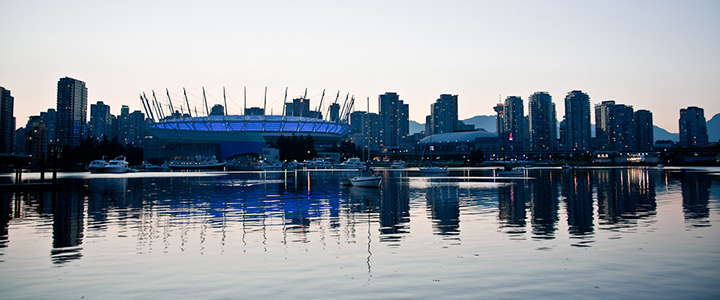
“Downtown is Vancouver’s primary business district, houses many arts, entertainment, and sports venues, and is close to several vibrant residential communities.”
HISTORY
“Just over a century ago, Vancouver was a two-block collection of buildings called Granville (now known as Gastown). This location on Burrard Inlet was competing to be the west coast terminus of the Canadian Pacific Railway. By 1887, a year after the City of Vancouver was incorporated, the first passenger train arrived at the foot of Howe Street, and future growth was assured. In the next seven years, a building boom began to move the city centre from Water and Cordova Streets up to Georgia and Granville Streets. Streetcar service was initiated in 1890, joining the waterfront to Granville, Pender and Cordova Streets.
The following decade confirmed Granville Street as the centre of Downtown, and a real estate boom spiraled land costs upwards. By 1912, a core office and shopping area was well developed, flanked by comfortable residential neighbourhoods. The period after World War I saw another economic leap forward and more Downtown development. The 1929 stock market crash halted it all, and began a thirty-five year period of very little change in the area.
The late 1960s and 70s saw rapid growth in the Downtown and adjacent areas such as the West End. Vancouver solidified its position as an international financial and business centre and white collar jobs in the city core multiplied. Pacific Centre Mall was developed and Granville Street was transformed into a transit mail. Rapid changes to the skyline, combined with urban renewal proposals for Gastown and a freeway through Chinatown lead to a surge of resident concerns about the future of the Downtown. Citizen involvement successfully defeated the freeway proposals, and in 1971 the provincial government designated Gastown and Chinatown as historic districts. The Robson Square Courthouse and Vancouver Art Gallery complex was completed in 1977 creating an important public space in the heart of the Downtown.
Industrial land surrounding False Creek was rezoned to permit comprehensive redevelopment into residential neighbourhoods. The early 80s saw a 60,000 seat indoor stadium called B.C. Place built just south of the Georgia Viaduct. In 1986 the north shore of False Creek was the venue for an international exposition, EXPO 86. The Canada Place Trade and Convention Centre was constructed on Burrard Inlet as Canada’s pavilion to the fair. It is also the city’s cruise ship terminal. The first phase of SkyTrain, linking Downtown to New Westminster, was also built to coincide with EXPO.
In the late 1980s, the Downtown was clearly in transition from a precinct dedicated mostly to commerce, to a cluster of neighbourhoods ringing a thriving office and shopping district. Council adoption of the Central Area Plan in late 1991 confirmed this direction by establishing overall goals and land use policy for the Downtown.” City of Vancouver
SOME OF THE COMMUNITIES
False Creek North
Located on the former EXPO 86 site, on the north shore of False Creek.
Yaletown
Once the city’s warehouse district, Yaletown is today a revitalized part of the city and a “trendy” place to live, work, and do business. The area north of Pacific Boulevard, between Nelson and Drake Streets, is home to a mix of art galleries, retail stores, restaurants, office and residential developments.
Coal Harbour
Overlooking Stanley Park and the North Shore mountains, Coal Harbour stretches from Canada Place to Cardero Street along the Burrard Inlet shore.
East False Creek
East False Creek is an extension of the False Creek North residential development on the old Expo 86 lands. This area, to the north of the Main Street SkyTrain Station and the Canadian National/Greyhound Bus Station, is positioned between Mount Pleasant and Chinatown.
Chinatown
With the completion of the transcontinental railway in 1887 Chinese labourers settled along the shore of False Creek on what is now Pender Street between Carrall and Columbia Streets. The community grew so that it was once the largest Chinatown in Canada, and the second largest in North America. The distinctive character of the area is evident in the architecture which features the unique recessed balconies, decorative parapets and cornices.
Gastown
The birthplace of Vancouver, originated in Maple Tree Square – the zero hundred block of Water Street where it intersects with Carrall Street – where Jack (Gassy) Deighton opened his saloon and the city’s first business. In April 1886 Gastown and the surrounding forest was incorporated as the City of Vancouver, in June the same year it burned to the ground. The area is a collection of 19th century buildings and early 20th century warehouses. Threatened with destruction by freeway and urban redevelopment projects in the 1970s, Gastown was designated as a heritage district by the provincial government.”